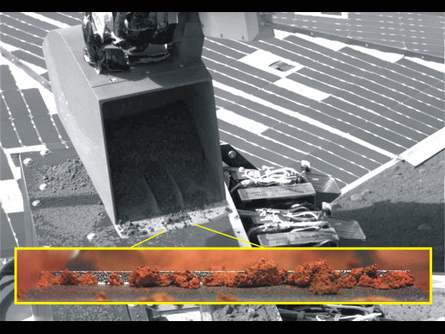Icy red planet
Mission to Mars finds water ice
By Emily Sohn
 |
|
The Phoenix Mars Lander’s robotic arm (pictured aboved) collected small clumps of Mars’ fine, red soil (inset). Analyses of the soil in one of the lander’s miniature ovens revealed that the planet may have once possessed the liquid water required for life.
|
| JPL/NASA, U. of Arizona, Max Planck Insitute |
On Earth, ice is just another reason to love or loath winter, depending on where you live and how you feel about cold weather. On Mars, ice is much more special than that — any evidence of frozen water on the Red Planet suggests that life could have survived there at one time.
Now, scientists have gathered the first direct evidence of water ice on Mars. The discovery came out of the Phoenix Mars Lander mission. The lander settled onto Mars on May 25 and has been poking and prodding at the planet’s soil ever since.
Soon after touching down, the lander’s robotic arm dug a trench called Snow White near the northern pole of Mars. One of the layers of icy soil the arm dug into was as hard as a concrete sidewalk, says mission specialist Ray Arvidson of Washington University in St. Louis. From Earth, Arvidson controls the lander’s robotic arm, which uses several tools to collect samples for the lander’s other instruments.
Arvidson directs the arm’s pinky-sized drill to loosen the hard soil. Then he guides a scoop to pick up the loose bits. From there, the shavings go into one of eight ovens that are part of Phoenix’s Thermal and Evolved-Gas Analyzer, or TEGA. The ovens allow scientists to analyze the soil by baking it: Scientists can tell which ingredients are in the soil because different ingredients melt at different temperatures.
After a month of mechanical troubles, the research team was finally able to bake its second sample. Some of the sample melted at 0° Celsius, the melting point of ice. The instrument also detected water vapor during the procedure. Both clues confirm the presence of water ice.
Previously, satellite images suggested that there might be water ice near the Martian poles. But the new discovery is the first direct confirmation that water ice currently exists anywhere on the Red Planet.
“Now, we have finally touched and tasted ice on Mars,” says William Boynton, a mission coinvestigator and lead TEGA scientist. “And I can say it tastes very fine.”
Originally, Phoenix was scheduled to stop its exploration at the end of August. But the new discovery is exciting enough that NASA officials plan to keep the lander alive for 34 extra days — until late September.
Scientists will use this bonus time to learn about the soil and atmosphere of Mars’ polar region. Now that the team has proof of water ice on the Red Planet, they can begin to investigate whether the planet’s icy layer of soil could have ever supported life.







